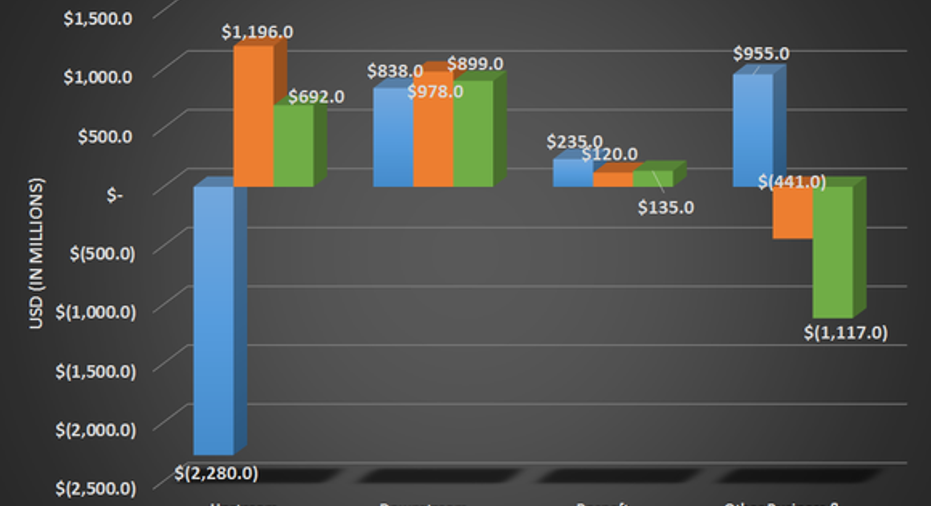BP's Earnings Keep Showing Progress, Even if the Headline Results Don't Say So

BP's (NYSE: BP) fourth quarter results were very similar to its integrated major peers: A slight downturn from the third quarter, but much stronger than the year before. When it comes to BP, though, there are lots of funky accounting things to look through to really understand what is going on at the business. Digging into these numbers, things are looking better by the day. Here's a quick look at the details of BP's quarter as well as what management has its sights on for 2017.
Image source: Getty Images.
By the numbers
| Results* | Q4 2016 | Q3 2016 | Q4 2015 |
|---|---|---|---|
| Revenue | $52,121 | $48,043 | $49,233 |
| Net Income | $543 | $1,577 | ($3,324) |
| Earnings per ADS (U.S. GAAP) | $0.16 | $0.51 | ($1.08) |
| Operational cash flow | $2,428 | $2,508 | $5,806 |
*in millions, except per share data. Source: BP earnings release.
At first glance, it would seem as though BP took a step backward this past quarter in terms of profitability. In the prior quarter, the company had a $1.4 billion benefit from an asset impairment reversal that added to the bottom line, whereas the past quarter that reversal gain was $292 million. There were also some tax gains in the third quarter that bumped those profit numbers.
If we were to strip away all of these one time gains and losses and use what BP calls its underlying replacement cost profit, then this past quarter the company pulled in $400 million in net income compared to a $933 million in Q3 2016 and a $196 million loss in Q4 2016. So the step backwards was quite a bit smaller than the headline results.
The promising sign for BP was that the company posted an underlying profit from its upstream production segment for the first time in several quarters. Higher price realizations and the end of some turnaround work in the prior quarter led to a $400 million gain on the upstream side. Again, this is before all of those one time gains and charges. For downstream refining, gains at its lubricants and petrochemicals business were more than offset by weaker fuel refining margins and some turnaround work at a major refinery. The results from its lubricants and petrochemials business are some of the best results it has posted in these segments.
Image source: Getty Images.
From a cash flow perspective, it also looks like BP took a big step backwards compared to the year prior. This is another one of those accounting quirks as the company has a $3 billion gain from a drawdown in working captial in the fourth quarter of 2015. So all things equal, it looks as though cash generation hasn't changed much lately. BP ended the quarter with $34.8 billion in net debt-debt minus cash on hand -- and has a net debt to capital ratio of 27%, which is within management's target range of 20%-30%
What management had to say
CEO Bob Dudley, on what he foresees for the oil market in the coming year:
What a Fool believes
While most other integrated oil and gas companies are still being reserved with their capital expenditure budgets, BP is actually upping its spending levels for 2017 in large part because it gave the green light for Mad Dog 2 in the Gulf of Mexico and acquired a 10% stake in Eni's massive Zohr gas field in Egypt. These new projects will add a bit to the budget as well as add some significant growth for 2020 and beyond.
The company is still sorting out some issues with the Deepwater Horizon spill, but the combination of better capital allocation and prudent cost management has put the company in a much better place than it has been in a long time. These may not show up in the income statement yet, but they should in coming quarters.
10 stocks we like better than BPWhen investing geniuses David and Tom Gardner have a stock tip, it can pay to listen. After all, the newsletter they have run for over a decade, Motley Fool Stock Advisor, has tripled the market.*
David and Tom just revealed what they believe are the 10 best stocks for investors to buy right now... and BP wasn't one of them! That's right -- they think these 10 stocks are even better buys.
Click here to learn about these picks!
*Stock Advisor returns as of February 6, 2017
Tyler Crowe has no position in any stocks mentioned. The Motley Fool has no position in any of the stocks mentioned. The Motley Fool has a disclosure policy.



















